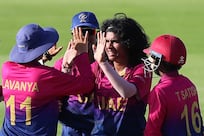Baseball's annual free agent draft takes place Tuesday and it has suddenly dawned on the people who run Major League Baseball that this is an event that could be used as a huge promotional tool for the game. Given that the first draft was in 1965, it must be assumed that these same people are somewhat slow learners. It wasn't long ago that baseball tried to hide the results of this event. Only a little more than a decade ago, teams were instructed not to release their full draft lists beyond the first round or so, out of fear that nefarious agents would use this top-secret information to wrangle bigger signing bonuses for their clients.
Now, the draft has come full circle. This year, for the first time, the draft will be held over two days, with the first few rounds held in prime time. The draft will be broadcast on the new MLB Network, giving the draft the same "big event" feel normally associated with the NFL and NBA drafts. In all likelihood, baseball's annual draft will never match those of their football and basketball brethren for one simple reason: high school baseball and college baseball, with few notable exceptions, will never come to close to matching the widespread appeal and acceptance of college football and college basketball in the states.
While virtually every player in the first round of the NFL and NBA are familiar to dedicated sports fans, the first-round selections in baseball's draft are largely anonymous. Moreover, there is no guarantee that even Top 10 picks will ever reach the major leagues, much less become stars. Projecting an 18-year-old high school star's career path is a decidedly inexact science. This year, the draft at least boasts some star power at the top.
Projected No 1 pick, Stephen Strasburg, a San Diego State junior with other worldly numbers, including 195 strikeouts in 109 innings with just 19 walks in that span. Strasburg routinely throws his fastball in the mid-to-high 90s and has been clocked at times at 103 mph. He's expected to be selected by the Washington Nationals, who could sorely use a player of Strasburg's potential and ticket-selling ability.
Some major league scouts believe that Strasburg could pitch successfully in the big leagues now, but the Nationals will resist the temptation to introduce him in the second-half of the season, opting to protect his long-term development. Beyond waiting for once-in-a-generation talents like Strasburg to come along, there's much that MLB could do to further enhance the draft. They could allow the trade of draft picks. Baseball is the only one of the four major North American sports which forbids this practice, which undoubtedly contributes to the baseball draft's low visibility.
Imagine this year in particular, where other teams could offer major league stars and top prospects for the right to select Strasburg. Imagine the attention this would bring to an otherwise low-drama event. Holding the draft in the off-season could help. Alone (again) among the four major sports, baseball is the only one which holds its draft in the middle of its own season, thus running the risk of having its own games overshadow what should be a publicity-generating event.
If baseball held its annual draft, say, at the winter meetings, it could better spotlight the proceedings, introduce its future stars with the media already in attendance and generate far more fan interest - especially if the move was done in conjunction with the trading of picks. Then again, that may be too much to ask. Change comes to baseball slowly. Perhaps in another decade or two. smcadam@thenational.ae




